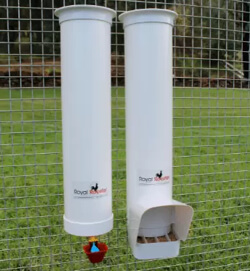
Many backyard chicken raisers start with good intentions to build a sizeable chicken coop but end up giving away their chickens because they feel raising chickens is quite troublesome. Such a feeling is understandable, considering that raising chickens isn’t easy. Besides, it requires time and effort. It also necessitates monitoring what your chickens eat daily to make them grow healthy and provide you with healthy chicken meat and eggs.
When raising chickens, you need to plan everything, from building your chicken coop to the kind of feeders you will install. Some feeders, for example, are easy to set up, but some require more elaborate setups. Moreover, some feeders are rat-proof, while others are not. So, you must be meticulous in selecting the feeders for your chicken coop setup.
What Are the Types of Chicken Feeders
Feeders are poultry equipment that you can use to feed your poultry birds. They come in varying setups and designs. If you are planning to build your chicken coop, you might as well check out the following available types of feeders in the market today:
1) Trough Feeders

A trough feeder can either consist of wood, carved stone, or metal feeder holding food for your poultry birds. You will usually find them fixed to the coop’s side. It can be a standalone container, allowing several birds to feed in a row.
The trough feeder is also open for refilling and is easy to maintain. Its streamlined design and high sides make it hard for birds to scratch or rake their feed using their beak or feet. However, if the trough feeder is a standalone unit with a roof, it will be best to set it up outside the coop.
A small trough feeder can easily get knocked off by chickens. Hence, it will be best to affix it to something sturdy. You can use the trough feeder for all feed types.
2) Open Container Bin

The open container bin is like the trough feeder. Yet, it is not as long as the trough feeder, making it difficult for many birds to eat simultaneously. For example, if you have multiple chickens to feed, you can use several open container bins positioned in different areas to avoid overcrowding.
Open container bins are not difficult to refill. They are also perfect as supplementary feeders to other feeders. You can also use them as special treat containers for scraps and working medication feed.
Chickens, however, might jump inside the bin and start scratching. If you got this problem, you could try using a “U-shaped” bin. Then, affix it to the wall to prevent chickens from jumping inside it. Besides, you can place a mesh over it to only allow the heads of the chicken to poke in.
3) Basic Feed Dispenser

Another type of feeder is the basic feed dispenser which comes in sizes from small to large, weighing around 40 pounds. These basic feed dispensers are often wrought in plastic. This plastic, of course, is UV-resistant.
You may find inexpensive feed dispensers. However, there are also feed dispensers with exorbitant prices, like those galvanized dispensers that are ridiculously expensive. Nevertheless, they could last for several decades.
Dispenser feeders dispense feed from a self-contained and enclosed container. Thus, the feed is safe from contamination and foraging rats. You can also hang this feeder to keep it out of reach of voracious rodents and to prevent chickens from scratching poop or dirt into their feed. You can also position this feeder on brick or concrete tiles to keep the food safe and free of debris.
You can use the feed dispenser to dispense dry feed. Besides, you can use it to dispense moist mash. You will also find feed dispensers with roofs to keep the food dry during rainy days.
4) Hanging Feeders

Another type of feeder is the hanging feeder, which is the best-selling feeder type currently. It relies on gravity when dispensing feeds. Once chickens take from the bottom, the gap gets quickly refilled by the trickling feed from above. This way of feeding is quite adequate, and most feeder types also work according to this principle.
Hanging feeders are easy to set up. You only mount them to a corner or a wall. Thus, it can be wall or corner mounted or hanging.
You can mount one or more of these feeders to ensure everyone can have their fill simultaneously. You can also set up these feeders either outside or inside the coop. Besides, you will find hanging feeders with rain guards to prevent them from getting doused in water during rainy days.
5) Tread-plate Feeders

One type of feeder that seems to be relatively new commercially is the tread-plate feeder. This feeder can hold up to 20 kgs of dry feed. Some tread-plate feeders can be quite expensive. The tread-plate feeder comes with a pressure plate system. This system comes with a plate on which the chicken could step.
Once the chicken steps onto this plate, the feeder lid opens, letting the feed trickle down. Once the birds lift their feet off the plate, the lid shuts.
This system helps prevent foraging rats from getting access to the feed. Besides, it can be water-tight and help prevent rainwater from drenching the feed.
Chickens need to be smart, however, or need the training to get used to stepping on the plate when they need to feed. Once they learned the trick, they could have their fill anytime they got an urge to eat.
Some poultry owners, however, say that the quick closing and opening of the lid sometimes frighten their chickens. Yet, soon enough, the chickens will learn the trick, and it will become second nature to them to step on the plate to get their feed.
6) PVC Tube Feeders

Another type of feeder that is relatively new to the commercial feeder market is the PVC Tube Feeder. This feeder has been popular among DIYers for several years, but it is relatively new to the market. PVC tubes, however, are not that expensive. So, making this type of feeder is not that costly. Nevertheless, if you don’t want to do it yourself, you can purchase PVC tube feeders.
Some PVC tube feeders can handle up to four kilograms of dry feed. Hence, these feeders are not as huge as other types of feeders. You can also refill these feeders with ease. However, you can’t use this feeder with moist mash and wet feed, for it will get clogged quickly. So, you can only use it with commercial pellets and whole grains.
You can use several PVC tube feeders to feed multiple chickens simultaneously. You can also find PVC tube feeders that are weather-proof. Besides, these feeders come with a simple design and are lightweight.
You can mount them to a wall, post, fence, or stake. If you set it up well, this feeder can be rat-proof, considering that rodents would find it hard to climb the slippery surface of the tube.
You can also easily clean this feeder, although some feed would accumulate underneath. Nevertheless, cleaning this feeder isn’t a big problem.
You can use this feeder as a secondary feeder, set at some distance from the main feeding area. This way, the naïve chickens that often get bullied will have their chance to eat on time.
7) Automatic Chicken Feeders

With the rapid development in automation, it will not be far-fetched that automation technology will get incorporated into the designs of feeders. If you got commercial-scale poultry, it would be best to use this feeder type to ensure that your flocks will eat at the right time.
Automatic feeders are computer-aided; as such, the feed gets deposited for ready access of birds, sans human intervention.
One problem with this setup is that you might be in for some technical challenges if there is a power outage. Besides, you might be forced to do the feeding manually during power outages.
On the other hand, you might find this setup costly if you got small-scale poultry. But if money isn’t an issue for you, you can go for this kind of feeder and automate your chickens’ feeding process.
8) Chick Feeders

The chicks will have difficulty competing with the adult birds during feeding time. So, you would need a chick feeder to cater to the small ones in your coops. Chick feeders, of course, are smaller versions of the large-sized feeders. Chick feeders are more often round bases or troughs.
Of course, chicks will soon become adults and outgrow these feeders. So, you don’t need to spend much on chick feeders.
9) Homemade Feeders
If you have a limited budget, you don’t need to break the bank just to provide your chickens with a suitable feeder. You can always rely on your resourcefulness and use recycled materials as your chicken feeders. You can, for example, utilize an unused old bucket for this purpose.
You can cut some holes on the bucket’s base and position this bucket on a plastic saucer that is sufficiently wide for the bucket. You can fill the bucket with feed, and gravity will let the feed trickle out of the holes into the saucer.
You can also have the saucer glued or affixed to the bucket’s bottom. Then, you can hang the bucket high enough using wire to allow the chickens to peck on the feed.
Which is Better: Metal or Plastic Feeders?
As you shop around for the ideal feeders for your coop, you will soon find that feeders are either made of metal or plastic. Metal feeders, of course, are more durable, but they are getting scarcer nowadays. Plastic has become very common nowadays, and you will find mass production of plastic feeders in the market today.
Plastic feeders, however, are easy to maintain and clean. Besides, they can also exhibit durability and are also corrosion and rot-free. However, plastic can become brittle during winter and might crack or break. Similarly, if the plastic is not UV-resistant, it might crack up under the constant barrage of UV rays.
Nevertheless, you can expect both materials to last for years as long as you maintain them well. So, weighing the pros and cons of using metal and plastic feeders will be best when searching for the best feeders for your chicken coop.
Conclusion
Whether you like it or not, if you will keep chickens to be self-sufficient with chicken meat and eggs, you need to plan everything. Raising chickens does not only entails building a chicken coop and stuffing it with chicks; it also involves regulating the food intake of your chicks to make them blossom into healthy and fully-grown chickens. And you would indeed need an excellent feeder to regulate the feeding process.
If you can avail of an automated feeder, that would be good. Besides, you can push your coop’s setup a notch if you do so. Similarly, incorporating the latest technology in automation could help ensure that your chickens’ feeding is on time. But if you don’t know how to automate your feeders, it will be best to choose among the rest of the feeder types mentioned above.






